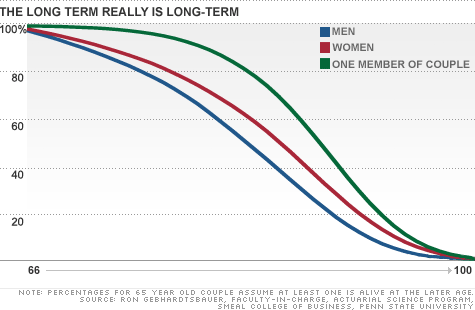
Chances of 65-year-old living to age ...
(MONEY Magazine) -- Why do I need my savings to last to age 100 if my average life span is much shorter? -- Mike Johnson, Fairfield, Ohio
In "The Flaw of Averages: Why We Underestimate Risk in the Face of Uncertainty," Stanford management-science professor Sam Savage illustrates the folly of planning using averages by recounting the tale of the statistician who drowns crossing a river with an average depth of three feet. The rub, of course, is that while the stream is shallow near the shore, it's 12 feet deep in the middle.
The idea of using your average life span for estimating how long your savings will have to last in retirement is similarly all wet -- and could leave you in the unpleasant position of having no savings but a whole lotta living to go.
Life expectancy isn't an estimate of how long you are likely to stay alive. It represents the average number of years a person of a given age is expected to live. These days, the life expectancy of a healthy 65-year-old man is another 20 or so years, while for a woman of the same age, it's an additional 22 years.
Many people will live longer. As the above chart shows, a 65-year-old man has a 30% probability of living to 90; a 65-year-old woman has a 40% chance. And the chance that at least one member of a 65-year-old couple will be alive at 90 is higher -- 60%.
When you arrange your finances based on how long someone your age is projected to live, you may be giving yourself a false sense of security.
More: Best money moves in your 40s and 50s
Let's say you're 65, have $500,000, and want to withdraw enough each year to live comfortably, but not so much that you'll spend your money too soon. If you assume your assets will have to support you for only 20 years, you could withdraw 5% of your savings initially and then increase it for inflation each year. With that regimen, you'd have about a 10% chance of depleting your money before age 85, according to T. Rowe Price's Retirement Income Calculator.
If you live longer the probability of your money running out rises. At the same withdrawal rate, it jumps to more than 30% if you live to 90, and almost 50% at age 95.
So if life expectancy isn't the right figure for retirement-planning, what is?
There's no single correct figure. In its Retirement Income Planner tool, Fidelity sets a default age of 92 for a 65-year-old man and 94 for a woman. T. Rowe Price's calculator uses 95 for all.
When Boston University economist Laurence Kotlikoff designed his ESPlanner retirement software, he set the target age at 100. "You have to plan for the possibility of reaching the maximum age because you might make it," he says. (All three calculators let you set a higher or lower age.)
More: Best investments at ages 55-plus
In reality, the vast majority of us won't live to 100, or even our nineties. So how do you balance the risk of assuming too short a life span and spending down your assets too soon, vs. erring on the side of longevity and living more frugally than need be?
Deciding between those two possibilities is personal. My take is that the prospect of having to scrimp in your final years -- or, worse yet, depend on the kindness of others -- is more unsettling than the possibility of dying with unspent assets.
Unless you have serious health problems or a family history of dying young, plan on living into your early or mid-nineties. If your ancestors are long-lived, you may want to aim for 100. And couples may want to plan for a husband dying first since women have longer life spans on average.
More: Money 101 - Getting the most out of your retirement money
Ultimately, you have no way of knowing when you'll depart this earth. Even online tools that fine-tune your life expectancy based on your health, behavior, and family history -- such as the one offered by Northwestern Mutual -- produce only an average.
Given that uncertainty, it pays to hedge your longevity bets another way once you retire: Devote a portion of your savings to an immediate annuity, which pays guaranteed income no matter how long you live.
What you don't want to do is plan as if your savings need to last only for an average life span. Do so, and you could find yourself in deep water later
Do you know a Money Hero? MONEY magazine is celebrating people, both famous and unsung, who have done extraordinary work to improve others' financial well-being. Send an email to nominate your Money Hero. ![]()

Carlos Rodriguez is trying to rid himself of $15,000 in credit card debt, while paying his mortgage and saving for his son's college education.
| Overnight Avg Rate | Latest | Change | Last Week |
|---|---|---|---|
| 30 yr fixed | 3.80% | 3.88% | |
| 15 yr fixed | 3.20% | 3.23% | |
| 5/1 ARM | 3.84% | 3.88% | |
| 30 yr refi | 3.82% | 3.93% | |
| 15 yr refi | 3.20% | 3.23% |
Today's featured rates: